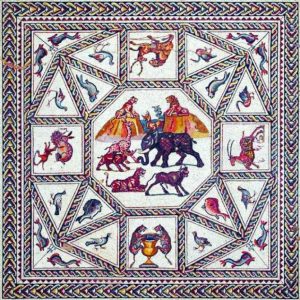
Visitors to Miami this winter travel season have a chance to meet a true “Roman Rock Star” up close in the magnificent Lod Mosaic, a third-century CE Roman mosaic from the Eastern Roman Empire in modern-day Israel.
The mosaic continues its transcontinental tour at the Patricia and Phillip Frost Art Museum FIU, the Smithsonian affiliate in Miami. Presented in association with the Israel Antiquities Authority, the mosaic has attracted crowds at the Louvre in Paris, the Metropolitan Museum in New York and the Hermitage Museum in Russia.
The exhibition in Miami, which opens Feb. 10 and closes May 15, has been underwritten generously by the museum’s patrons Patricia and Phillip Frost, and provides a rare opportunity to to see one of the world’s finest, largest and most well-preserved ancient mosaics up close.
This spectacular discovery is lauded for its remarkable state of preservation. Because Miami’s peak tourism season coincides with the exhibition, travelers from all over the world who flock to the sunshine capital during the winter also will be able to witness the 1,700-year-old masterpiece.
Critics and reviewers have heralded the artist who created this masterwork as one of the world’s greatest mosaic artists ever, and have called this mosaic superstar “The Roman Rock Star.” The Opening Reception will take place Wednesday, Feb. 10, 5-8 p.m. (open free to the public, but due to crowd capacity RSVP is recommended in advance to artinfo@fiu.edu). The exhibition will remain on view through May 15. The museum is on the campus of Florida International University, located at 10975 SW 17 St.
 Especially during today’s troubled times with heritage sites in danger in war-torn areas, the Lod Mosaic provides a spectacular example of rescue archaeology and conservation.
Especially during today’s troubled times with heritage sites in danger in war-torn areas, the Lod Mosaic provides a spectacular example of rescue archaeology and conservation.
The Israel Antiquities Authority saved the Lod Mosaic after it was discovered by a construction crew during a 1996 excavation to widen a roadway.
The Lod Mosaic dates back to the third century CE when the town of Lod was a part of the Roman Empire. The exquisitely detailed mosaic is believed to be the floor of a large audience room in a grand villa owned by a wealthy Roman merchant whose trade route crossed between Jerusalem and the Mediterranean.
The exhibition’s title, “Predators and Prey,” references the marvelous menagerie of exotic animals portrayed. The mosaic is of no religious affiliation, residents at the time were mostly Pagans, Christians and Jews.
The Lod Mosaic is one of the most-viewed Israeli touring exhibitions in history. When the Israel Antiquities Authority originally excavated the mosaic and opened it to the public for only one weekend, more than 30,000 people traveled to Lod to see the ancient marvel during the two-day period. “We are absolutely delighted and honored to have been afforded this once-in-a-lifetime opportunity to exhibit a significant work from Roman antiquity at the Patricia & Phillip Frost Art Museum” said Dr. Jordana Pomeroy, the museum’s director. “The Lod Mosaic’s excellent state of preservation and the IAA’s superior conservation allow us to appreciate how the finest mosaic work can bring alive the ancient world. The mosaic captured the interest of Patricia and Phillip Frost who wanted to share their enthusiasm with the Miami community through this exhibition.”
The Israeli town of Lod stands on the site of the ancient city of Lydda, which developed in a fertile plain on an important trade route, the Via Maris, from Egypt to Syria and Mesopotamia. A center of culture and craft production, after being destroyed by the Romans in 66 CE during the first Jewish-Roman War, the city was rebuilt with the name Diospolis, the “city of Zeus.” Around 200 CE, Septimius Severus made it a Roman colony.
Archaeologists have calculated that more than two million tesserae (ancient tiles) were used to create the 1,700-year-old masterwork. Three central panels were chosen from the excavation for the traveling exhibition, two rectangular end panels surrounding a large square central medallion. Featured are indigenous animals coexisting with ferocious wild creatures such as lions and tigers, an elephant and a giraffe, and Asian water buffalo, plus marine life, a sea monster and merchant ships. The mosaic holds unresolved mysteries, adding to its allure. Why are there no deities or human beings portrayed, something highly unusual for such a grand floor mosaic from this time period? Mosaic pavements were integral to ancient architecture, and the traveling exhibition is uniquely displayed on the floor as it was meant to be seen.
Flash-forward 1,700 years and the current municipality of Lod and the Israel Antiquities Authority have recognized this opportunity to create a tourism center focusing on its newly recovered ancient mosaics. After its exhibition in Miami at the Patricia & Phillip Frost Art Museum FIU, the mosaic will return to Lod where the Shelby White and Leon Levy Lod Mosaic Center is currently under construction.
Admission to the Frost Museum always is free. The Frost is an American Alliance of Museums accredited museum, and is located at 10975 SW 17 Street, across from the Blue Garage and adjacent to the Wertheim Performing Arts Center. The museum is open to the pubilc Tuesday through Saturday, 10 a.m.-5 p.m., and Sunday, noon-5 p.m. Closed on Mondays and most legal holidays. For more information, call 305-348-2890 or visit online thefrost.fiu.edu .





